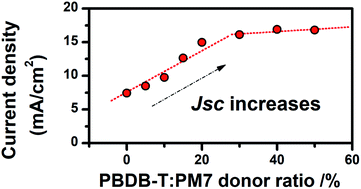Improving quantum efficiency in organic solar cells with a small energetic driving force†
Abstract
Organic solar cells based on a polymer donor (PM7) and a non-fullerene acceptor (Y5) with a very small energetic difference between the local excited state and the charge transfer (CT) state are investigated. We find that the small energetic difference (ΔECT) leads to a low voltage loss (0.44 eV). However, the short-circuit current density (Jsc) of the solar cell based on PM7:Y5 is very low, due to monomolecular recombination of the CT state excitons, limiting the internal quantum efficiency of the device. To solve the problem with the inefficient exciton dissociation, a polymer donor (PBDB-T) with a similar chemical structure to PM7 is employed as a second donor component for constructing ternary solar cells. We find that the frontier energy levels of the two donors are hybridized, allowing us to realize fine-tuning of the effective energy of the CT state and ΔECT of the ternary blend, by varying the PBDB-T content. As a result, a significantly improved CT state dissociation efficiency is achieved by adding a small amount of PBDB-T in the active layer. Meanwhile, the low voltage loss property of PM7:Y5 is very well maintained in the ternary solar cell, due to the energy level hybridization of the donor materials.

- This article is part of the themed collection: Journal of Materials Chemistry A Emerging Investigators


 Please wait while we load your content...
Please wait while we load your content...